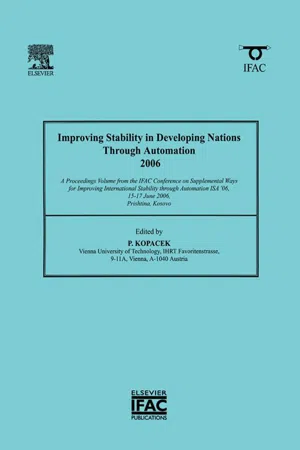
- 128 pages
- English
- ePUB (mobile friendly)
- Available on iOS & Android
Improving Stability in Developing Nations through Automation 2006
About This Book
Technological development has caused profound changes and social stability. Regions which have had stable populations for centuries have experienced enormous population growth leading to the emergence of sometimes unmanageable megaplex cities as well as bringing about macroscopic environmental change. The scope of this IFAC SWIIS Conference is to offer insights into mitigating unwanted side-effects of rapid development and to share methodologies for appropriate ways of managing the introduction of technologies which will alter social stability.
Contributions included in Improving Stability in Developing Nations through Automation 2006 cover a very broad field of interest for subjects such as social aspects of technology transfer, managing the introduction of technological change, ethical aspects, technology and environmental stability, and anticipating secondary and tertiary effects of technological development.
- 3 survey papers, 17 technical papers and a summary of the panel discussion
- Bringing together scientists and engineers working in these subjects to discuss solutions
Frequently asked questions
Information
Mechatronics Education and International Stability: The Development of University-level Education Programmes in Advanced Engineering in Kosovo
2 LARM: Laboratory of Robotics and Mechatronics, University of Cassino, Italy
3 University of Business and Technology, Pristina
4 ISOL Research Centre, Waterford Institute of Technology, Republic of Ireland
Abstract
1 BACKGROUND AND CONTEXT
2 MECHATRONICS & ENGINEERING MANAGEMENT
Table of contents
- Cover image
- Title page
- Table of Contents
- Copyright page
- Preface
- Part 1: Survey Papers
- Part 2: Mechatronics
- Part 3: Various
- Part 4: Privacy, Security and Ethical Issues
- Part 5: Energy
- Part 6: Robotsoccer
- Part 7: Panel Discussion
- Author’s Index